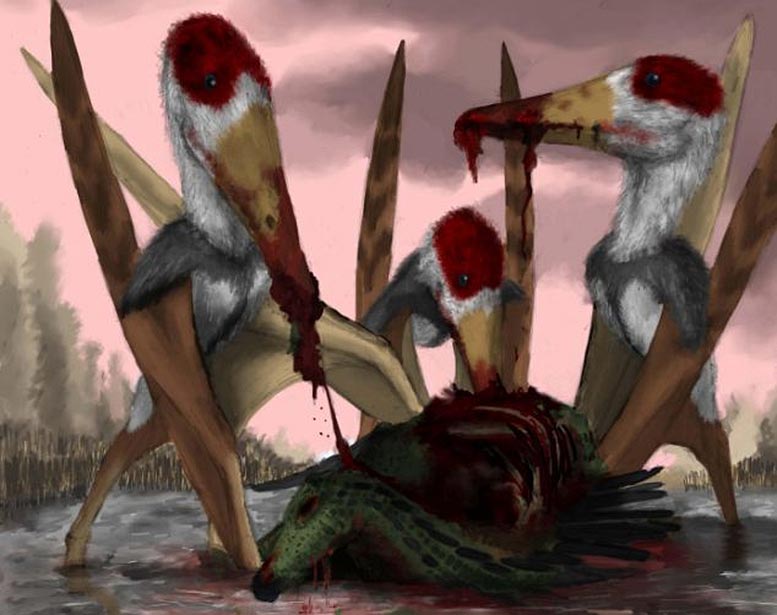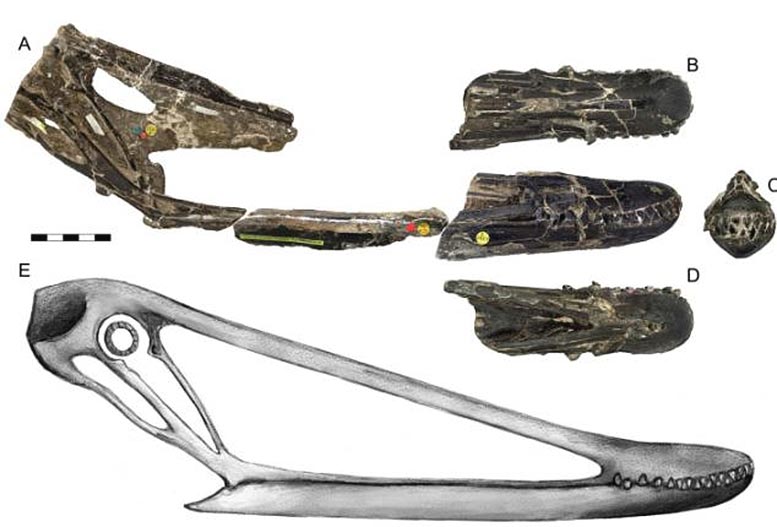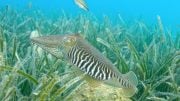New research has allowed paleontologists to gain new insight on a prehistoric piece of jaw from a pterosaur specimen, Istiodactylus latidens, which has been housed in the Natural History Museum for over a century.
The prehistoric piece of jaw has been housed in the Natural History Museum collections in London for over a century, but its significance was not appreciated until now. The new study means that the dimensions of the creature’s skull can be reconstructed more accurately, allowing paleontologists new insights into its feeding habits. The fragment indicates that the pterosaur in question was a scavenging, vulture-like creature which lived off the carcasses of dinosaurs.
The research, by Dr. Mark Witton, a paleontologist at the University of Portsmouth, was published this week in the international Public Library of Science journal, PLoS ONE.
Dr. Witton specializes in pterosaurs, enormous winged creatures which soared in the skies when dinosaurs roamed the earth. On a recent visit to the museum he realized that the fragment represented a more important piece of the jigsaw making up the skull than previously realized. The historically significant pterosaur specimen, Istiodactylus latidens, consisted of a skull broken into two large pieces representing the braincase and jaw tips, but little consideration had been given to a third element that seems to bridge the gap between them.
For almost 100 years, the creature was thought to have a very long, low skull exceeding half a meter (20 inches) in length but its exact proportions were never clear as only the jaw tips and braincase of the animal had been studied. Witton suggests that the third fragment reveals an unusually short and tall cranium and, combined with previous observations on the unusual teeth of this animal, he suggests that it provides an improved understanding of Istiodactylus diet and foraging habits.
He said: “Istiodactylus is an exceptional creature possessing unusual, interlocking ‘cookie cutter’ teeth with razor edges. These have suggested to some that this pterosaur was a vulture-like scavenger, but supporting evidence from the rest of the skull was lacking.
“This fragment suggests the skull was a good 20 percent shorter than previously supposed so, instead of a very long, low skull, it appears to have had quite the opposite – very short, very wide, and very tall. This was rather unexpected as we thought we were very familiar with its anatomy, but it seems it is far more distinctive than we previously realized.
Dr. Witton said that it was not unusual for fragments of fossil animals to be reinterpreted years later, by someone with a new pair of eyes.
“There may be countless similar stories waiting to be told. The Natural History Museum has an extensive collection of pterosaurs and other fossils with entire wings dedicated to fossil storage. Exciting new ‘discoveries’ amongst this collection are commonplace including particular details of well-known specimens and sometimes even fossils representing entirely new species may be underestimated by visiting researchers for many decades. They need the right expert – and perhaps a little good luck – to be noticed and appreciated. ”
The third fragment indicates that the creature’s cheek bones were incredibly slender – only 6 mm (0.24 in) tall in a skull around 450 mm (18 in) long. By contrast, other parts of the skull were very robust.
“Modern scavenging birds have similar skull constructions, possessing both strong and weak skull components. Feeding on dead flesh allows them almost complete control over how they feed, so they can afford to have some weaker regions along their jaws without the worry of breaking them when biting into carcasses.
The proportionally wide, tall skull would also anchor a good set of neck muscles, indicating a strong neck which is another feature shared with vultures which use their strong necks to pull carcasses apart. When considered with the shearing teeth, these attributes provide good evidence of scavenging lifestyles in these animals.”
The specimen of Istiodactylus was discovered on the Isle of Wight in late 1904 and has been in the Natural History Museum’s collections since 1911.
Reference: “New Insights into the Skull of Istiodactylus latidens (Ornithocheiroidea, Pterodactyloidea)” by Mark P. Witton, 21 March 2012, PLoS ONE.
DOI: 10.1371/journal.pone.0033170











Be the first to comment on "New Insight on Pterosaur Specimen, Istiodactylus Latidens"